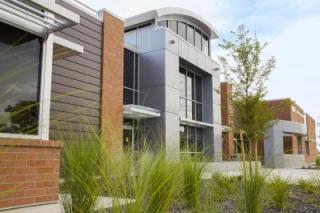Aug 21 2015
With the opening this week of the Systems Engineering Building at the Department of Energy's Pacific Northwest National Laboratory, a new suite of capabilities become available to researchers and industry to tackle the nation's top challenges in grid modernization, buildings efficiency and renewable energy integration.
 PNNL's new Systems Engineering Building arms researchers and industry to tackle top energy challenges with a unique suite of capabilities, including power grid and buildings control rooms, specialized laboratories, real-time grid data and access to advanced computation. Credit: PNNL
PNNL's new Systems Engineering Building arms researchers and industry to tackle top energy challenges with a unique suite of capabilities, including power grid and buildings control rooms, specialized laboratories, real-time grid data and access to advanced computation. Credit: PNNL
The LEED Gold-certified facility houses power grid and buildings control rooms, testing platforms and a number of laboratories to address a broad range of energy challenges. The facility also features the latest in industry software and real-time grid data with access to advanced computational capabilities that allow researchers to design, test and evaluate tools and concepts in a setting that mirrors current industry conditions.
"By linking SEB's new, high-speed data streams with PNNL's high-performance computing capabilities, we can see the grid as never before, enabling improvements to today's tools as well as completely new, predictive capabilities," said Steven Ashby, PNNL laboratory director. "The SEB enables researchers to work side-by-side with industry to accelerate these advancements, which are critical to achieving DOE's vision of a reliable, secure and sustainable power system."
The building is being dedicated on August 19 by DOE Deputy Secretary Elizabeth Sherwood-Randall; Sen. Patty Murray (D-WA); Rep. Dan Newhouse (R-WA); and other key industry partners and stakeholders. A recorded webcast of the dedication, overview video and other resources can be found on the SEB dedication page.
Multitude of resources under one roof
Through the SEB, PNNL is expanding its Electricity Infrastructure Operations Center to include two power grid control rooms that can be configured to accommodate a variety of industry testing needs and scenarios.
As one of the first industry partners to use the new facility, IncSys CEO Robin Podmore was impressed with its capabilities. "We train grid operators from around the world, such as those in Brazil before the World Cup," Podmore said. "PNNL's new facility provides the capabilities and training environment industry has been waiting for. It is the best mock control room facility for training and human performance evaluation I have seen in the world."
The facility also houses PNNL's Building Operations Control Center to better integrate grid and buildings research, for example designing and testing new buildings control strategies that would increase energy efficiency while reducing strain on the grid.
"With the new capabilities at SEB, we've turned PNNL's campus into a grid-buildings testbed to investigate how we can turn buildings and other traditional energy-consuming devices into valuable resources for the power system," said Carl Imhoff, manager of PNNL's Electricity Infrastructure programs. "Transforming buildings into responsive, two-way assets holds tremendous potential to increase grid reliability and control as well as integrate renewable energy."
Key to this effort is the use of PNNL's Volttron™, which enables appliances and other devices to communicate among each other to prioritize power needs and deliver electricity accordingly. The technology is open source and publicly available, an approach PNNL pursues whenever possible as a means to speed development and industry adoption. Another example is PNNL's GridLAB-D™, a first-of-its-kind analysis and simulation tool that enables users to see - in extremely high resolution - how making changes to one part of the grid, such as incorporating more wind power, affects other parts of the system.
SEB also houses the Power Electronics Laboratory, which provides dedicated lab space for PNNL's electric vehicle charging, energy storage and controls research. The adjacent outdoor pad provides space to connect to even larger assets, such as utility-scale energy storage units and commercial-grade roof top air conditioners.